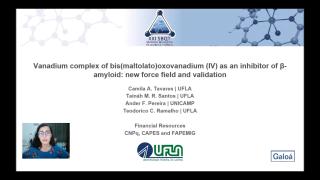Anais do Simpósio Brasileiro de Química Teórica
Anais do XXI Simpósio Brasileiro de Quimica Teórica - Vol. 1 2021
Role of coulomb interactions and density on the viscosity and non-newtonian behavior of ionic liquids – a molecular dynamics study
Como citar esse trabalho?
Para citar este trabalho use um dos padrões abaixo:
Como citar esse trabalho?
- Tipo de apresentação: Apresentação Oral Síncrona / Synchronous Oral Communication
- Eixo temático: Dinâmica Molecular
- Palavras chaves: IONIC LIQUIDS; non equilibrium molecular dynamics; rheology;
Autoras(es):
- 1 Universidade de São Paulo
Role of coulomb interactions and density on the viscosity and non-newtonian behavior of ionic liquids – a molecular dynamics study
Kalil Bernardino
Universidade de São Paulo
Agora você poderia compartilhar comigo suas dúvidas, observações e parabenizações
Crie um tópico- Tipo de apresentação: Apresentação Oral Síncrona / Synchronous Oral Communication
- Eixo temático: Dinâmica Molecular
- Palavras chaves: IONIC LIQUIDS; non equilibrium molecular dynamics; rheology;
Autoras(es):
- 1 Universidade de São Paulo
Ionic liquids (ILs) are considered green alternatives to traditional lubricants, but for this application the relation between viscosity and molecular structure should be well established.
In this work, the role of coulomb interactions and of liquid density over the viscosity and shear thinning of ILs were investigated by non-equilibrium molecular dynamics (NEMD).
NEMD permits to study the viscosity at different shear rates and explain the changes based on molecular structure.
The largest contribution to high viscosity of ILs come directly from coulomb interactions, with smaller but significant effect of density.
Congratulations and questions, Rodolfo Izquierdo TCG– UFRGS
Rodolfo Enrique Izquierdo Soto
Good afternoon, congratulations, . Dr. Bernardino, the chemical modification of the cations in ionic liquids could guide their application as new materials for catalysis and more recently as materials for the storage of gases. How is the performance of your models in the presence of cations with greater structural complexity, i.e., larger and substituted cations?
I know that is not the focus of your research, however, with the goal of in silico design of new ionic liquids, do you know of any precise theoretical description model for melting and boiling points for complex ionic liquids?
Thank you, excellent presentation.
- 1 like
- 2 respostas
Parabéns
Jorge Maurício da Silva Brito
Oi Kalil, boa noite.
Quero parabenizá-lo pelo excelente trabalho. Adorei.
- 1 resposta
Kalil Bernardino
Obrigado! Esperamos publicar esses resultados em breve!
Discussões Científicas de Qualidade
Com ~200 mil publicações revisadas por pesquisadores do mundo todo, o Galoá impulsiona cientistas na descoberta de pesquisas de ponta por meio de nossa plataforma indexada.
Confira nossos produtos e como podemos ajudá-lo a dar mais alcance para sua pesquisa:
Como citar esse proceedings?
Esse proceedings é identificado por um DOI , para usar em citações ou referências bibliográficas. Atenção: este não é um DOI para o jornal e, como tal, não pode ser usado em Lattes para identificar um trabalho específico.
Verifique o link "Como citar" na página do trabalho, para ver como citar corretamente o artigo



Kalil Bernardino
Good afternoon, Rodolfo!
Thank you for the question!
The method of molecular dynamics can capture, in principle, any effect due to changes in the molecular structure of the cation or the anion. However, in this particular work, we used a simplified model, which is called a coarse grained (CG) force field. In a CG model, several atoms are grouped together into a single interaction site. For instance, the [BMIM] cation here is described by only 4 interaction sites, and the anion [BF4] by a single interaction site. This has the advantage to reduce the computational cost of the simulation but has the drawback to loose some atomic details. For instance, there is no explicit hydrogen bond or dipole interactions in this CG model, and the expected effect of hydrogen bonds is taken implicity into dispersion interaction. So, the use of coarse grained models limit the kind of structural change that can be described by the simulation. A small growth of an alkyl chain (going from 4 to 5 C atoms, for instance) will hardly be captured. But a large change, for instance, going from 4 to 8 C atoms in a carbon chain, this can be captured by the model. In this particular force field, is easy to increase the size of alkyl chain by amounts of 4 C atoms at each time. A substitution of an acid hydrogen of imidazolium ring by a CH3 group can be described by using a less attractive parameter for the interaction between imidazolium ring and the anion, but this would need some validation.
For subtle structural changes, I would recommend the use of an atomistic force field, where all atoms are explicit described. We used an atomistic force field on this PCCP work to compare the effect of different anions in the viscosity of ILs: https://pubs.rsc.org/en/content/articlelanding/2021/cp/d1cp01205c
In any case, a classical molecular dynamics simulation will be as good as the force field used. The force field is basically the set of parameters need to describe the inter and intra molecular interactions between different atoms or groups of atoms in the model system. We have now very good force fields to aprotic ILs, but for protic ILs I still see a lot of problems, especially when trying to include effects of electronic polarizability.
I hope I had answered your question, despite I'm not currently working in the problem of gases absorption, there is simulation works related to this. Two authors I personally know and that are working with simulations on this subject are Luciano Tavares (who is also in this conference) and Agílio Pádua. Maybe you can look for their recent works.
Best,
Kalil
Rodolfo Enrique Izquierdo Soto
Muito Obrigado